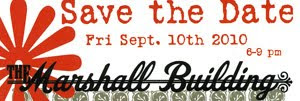I suppose it could be seen as an odd kind of experiment: if the entire audience of the large central screen in the Oriental Theater were strung out in a single line, how far would it extend? Just before the doors opened at about 7:30 last night there were a thousand people lined up along Farwell to the corner of Ivanhoe Pl., all the way down to the corner of Prospect Ave. and then most of the distance to the next corner, well over halfway around the entire city block.
The crowd, all ticket-holders and therefore assured (presumably) of a seat, remained calm and good-natured about it, but cell phones were buzzing along the entire line. I guess it could also be seen as a test of Milwaukeeans' patience. One does have to wonder how it would have played out on a cold, rainy day.
Is this a measure of the festival's success or simply someone's misjudgement? Is the movie schedule too crowded to allow one audience to exit the theater in time to let a new audience in without waiting outside?
The
good news for the festival is that they are selling a lot of tickets and filling the theater. The festival has endured a couple rocky years and it's great to see the enthusiasm. In order to maintain this momentum, festival organizers will have to consider how to prevent an embarrassing repeat of this situation. The good news for
me was that I got in to see the movie this time (see
yesterday's post.)
And it was definitely worth waiting for (in the pleasant conditions and with the cooperative crowd.)
A Funny Kind of Story takes us inside a psych ward - and inside the head of Craig, the depressive main character who can't quite commit to following through with his suicidal inclinations. Vaguely reminiscent of
One Flew Over the Cuckoo's Nest, this is a more restrained, subtle, and introspective story. It is clever, funny, and thoughtful. Although it's been a long time since I was an adolescent myself, I could easily identify with Craig's internal confusion and tribulations. After convincing the ER doctor to admit him to the psych ward, Craig quickly decides that he's in over his head and the audience, too, is subjected to the relativity of mental distress. Craig seems so normal. (
I'm crazier than him!) How many kids grow up today driven by familial and societal pressures to this malaise, this vague unease and incipient anxiety? How many of us, even as adults, need to be medicated to withstand a world full of ever-increasing pressures--to succeed, to consume, to raise healthy children, to see this show, to write about that, to do the right thing?
Again, to see more about the Milwaukee Film Festival, go to
Milwaukee Film.

.jpg)
.jpg)

.jpg)














